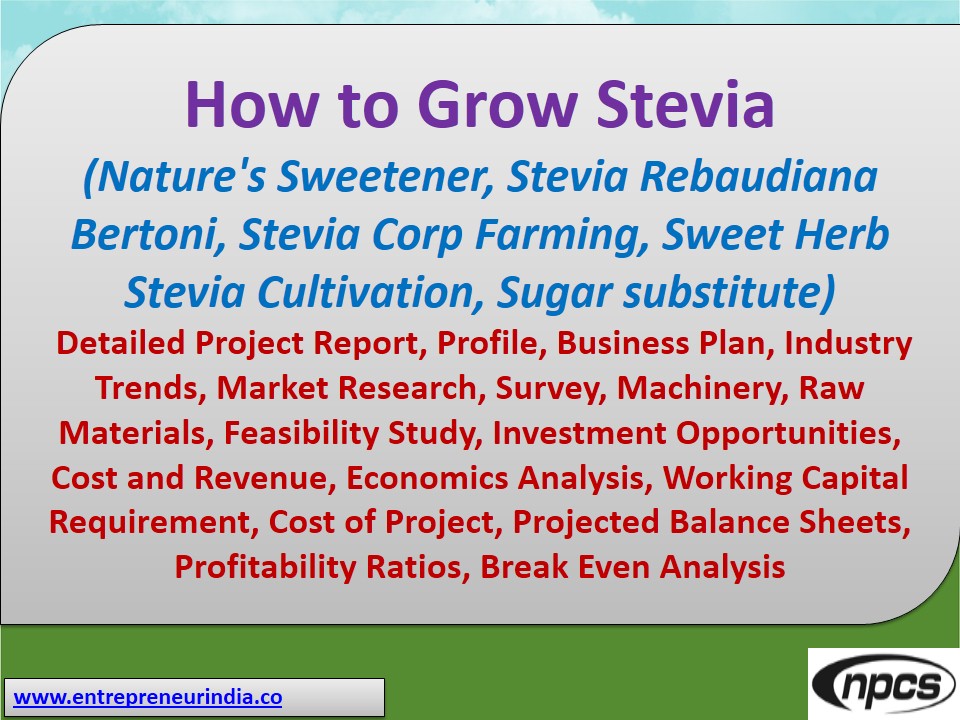
Stevia, a naturally sweet herb, has gained global attention as a healthy sugar alternative. Derived from the leaves of Stevia rebaudiana, this plant contains compounds like stevioside and rebaudioside, which are 200 to 300 times sweeter than table sugar. Unlike synthetic sweeteners, stevia comes with zero calories and is suitable for diabetics, making it a lucrative crop for modern farming entrepreneurs. If you’re planning a sustainable, health-driven farming project, Stevia Cultivation offers promising returns with relatively low input costs.
See Also – Plastic Manufacturing
How to Start Stevia Cultivation: Step-by-Step Guide
1. Understanding the Crop
Stevia is a perennial shrub that grows up to 60–80 cm tall. It thrives best in sub-tropical and tropical climates. Ideal growing temperatures range from 20°C to 30°C. The plant is sensitive to frost and prefers rich, well-drained loamy soil with a pH between 6.5 and 7.5. Ensure sunlight exposure of at least 12 hours for optimal leaf development.
2. Land Preparation
Start with one deep ploughing followed by two to three harrowing sessions. Make raised beds to improve drainage and reduce root rot risks. Add well-decomposed farmyard manure or compost to enhance soil fertility. Organic soil boosters help increase yield and improve the quality of leaves.
3. Propagation and Planting
Stevia Cultivation is mainly done through stem cuttings or tissue culture methods. Seeds have low germination rates and are less reliable.
-
Cuttings of 8–10 cm length with 3–4 leaves are selected.
-
Treat the cuttings with rooting hormone and plant in nursery trays.
-
After 25–30 days, transfer them to the field when they have strong roots.
Planting is done at a spacing of 40 cm × 40 cm to ensure proper aeration. The best time to transplant is just before the monsoon season.
4. Irrigation and Fertilization
Stevia requires moderate water supply. Avoid waterlogging as it can damage roots. Drip irrigation is most effective as it delivers water directly to the roots and conserves moisture.
Use organic fertilizers like vermicompost, cow dung, or neem cake. Avoid chemical fertilizers and pesticides to maintain the plant’s organic value. Apply micronutrients like zinc and boron once every two months to boost leaf growth.
5. Weed Management and Crop Care
Manual weeding is recommended every 20–25 days. Avoid deep tilling, which can harm root systems. To protect the crop from pests like aphids and whiteflies, use natural insect repellents such as neem oil or garlic-chili sprays. Mulching with dried leaves or crop residue helps retain moisture and suppress weeds.
Intercropping with legumes can improve soil health and reduce pest infestation. Proper sunlight, adequate spacing, and regular pruning also contribute to a healthier crop.
6. Harvesting
You can harvest the first crop about 3–4 months after transplantation. Leaves are plucked just before flowering when their sweetness is highest. Cut the stems 10–15 cm above the ground to allow for regrowth. On average, three to four harvests are possible in a year depending on climate and care.
Post-harvest, the leaves should be dried in the shade to preserve their natural sweetness. Avoid sun-drying as it degrades the steviol glycosides.
7. Yield and Income Potential
A well-maintained Stevia Cultivation field can yield around 2.5 to 3 tonnes of dry leaves per acre per year. The leaves are sold at prices ranging from ?150 to ?250 per kilogram, depending on quality and market demand.
This means that one acre of land can potentially generate an annual income of ?3.75 lakh to ?7.5 lakh, making it a highly profitable venture. Value addition, such as making stevia extract or powder, can further increase margins.
8. Processing and Marketing
Processing involves drying, crushing, and extracting sweet compounds from leaves. These extracts are used in food and beverage industries, pharmaceuticals, and even cosmetics.
There is rising demand from companies producing sugar-free products like soft drinks, bakery items, herbal teas, and diabetic supplements. You can sell dried leaves directly to processors or set up a small extraction unit for better profit margins.
Focus on organic certification, eco-friendly packaging, and online presence to reach health-conscious consumers. B2B tie-ups with food companies or pharmaceutical firms can ensure regular income.
9. Investment and Business Setup
Initial costs include land preparation, seedlings, irrigation systems, organic fertilizers, and basic processing equipment. Approximate capital investment for one acre may range from ?75,000 to ?1.5 lakh.
Government subsidies for organic farming and medicinal plants can help reduce costs. Contact agricultural departments, NABARD, or horticulture boards for financial support and training programs.
Make a detailed business plan outlining production, expenses, pricing, and marketing strategies. You can even explore farmer producer organizations (FPOs) for collective selling and better price negotiation.
10. Challenges and Solutions
Like any farming business, Stevia Cultivation comes with challenges. Low-quality planting material, poor soil, or irregular irrigation can affect yield. To overcome these issues:
-
Source high-yielding stevia varieties like SRB-123 or Madhura.
-
Regularly test soil for pH and nutrients.
-
Use disease-free planting material from certified nurseries.
-
Attend workshops or connect with stevia experts and cooperatives.
With a learning mindset and consistent care, small issues can be resolved quickly, ensuring long-term success.
See Also – Printing Press Business
Conclusion: A Sustainable Business Opportunity
The growing health consciousness and demand for sugar alternatives make Stevia Cultivation a smart investment for new-age entrepreneurs and organic farmers. It offers a unique blend of economic returns and environmental sustainability. With minimal input costs and the ability to grow in diverse climates, stevia is emerging as a top contender in the natural sweetener industry.
Now is the perfect time to venture into this profitable green business. Whether you’re a seasoned farmer or a startup investor, the path to a healthy, sustainable future begins with a single sweet leaf — stevia.
Contact Us





